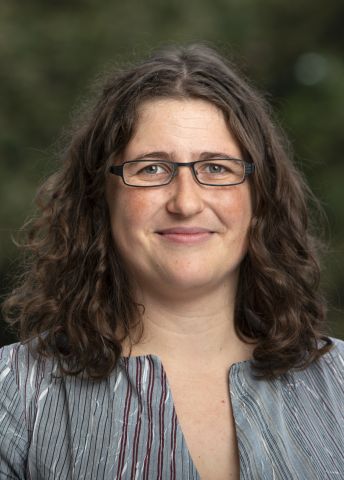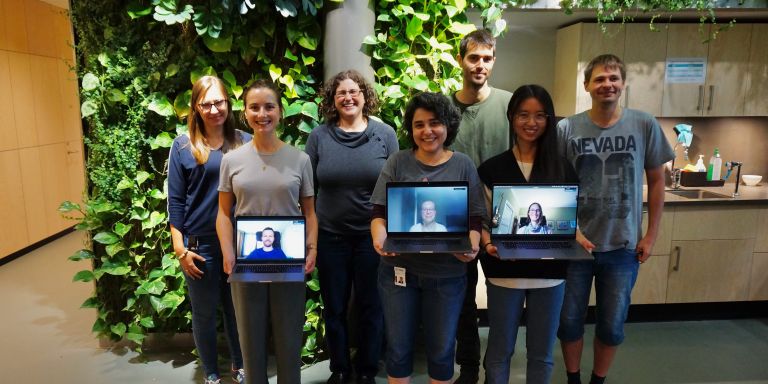
Katja Petzold
Associate Professor of Biophysics
Wallenberg Academy Fellow 2019
Institution:
Karolinska Institutet
Research field:
Developing methods to examine molecules in living cells


Wallenberg Academy Fellow 2019
Institution:
Karolinska Institutet
Research field:
Developing methods to examine molecules in living cells
During the pandemic Petzold is trying to work from home as much as possible. This suits her just fine this particular spring day, since her young son is a little unwell and is home from pre-school.
“It’s a tricky balancing act being a mother and welcoming new colleagues to the lab,” she says.
Scientific researchers are a peripatetic breed, staying in one place for a while and then moving on. Petzold’s team at Karolinska Institutet in Solna, just north of Stockholm, is no exception. Her PhD students, postdocs and researchers – 15 people in all – represent different branches of biochemistry, pharmacology, molecular biology, chemistry and physics. Her network includes cutting-edge expertise at academic institutions in Sweden, France, Austria, South Africa and the U.S. Together they are attempting to find methods of showing how miniscule molecules in living human cells react to events in their immediate surroundings.
Studies of biological structures are usually performed in vitro, i.e. in test tubes.
“It’s a highly simplified system that doesn’t provide enough information to develop good drugs for human cells,” Petzold says.
She is developing methods of examining both structure and dynamics in living cells so she can capture the whole process. Being chosen as a Wallenberg Academy Fellow enables her to find out how everything is coordinated.
“Each answer that we find leads us on to the next question. I am fortunate that our funding is secured and we can continue to seek new answers.”
Petzold’s team is using nuclear magnetic resonance (NMR) to study the structures down to atomic resolution. NMR works roughly like MRI, which is used for diagnostic purposes in the medical sector.
Ribonucleic acid (RNA) is central to processes in a cell. RNA is usually described as messengers carrying information from genes to proteins about what their structure should be. RNA also has other functions.
MicroRNA are short, single-stranded RNA molecules, found naturally in human cells. They attack messenger RNA in order to monitor and regulate the synthesis of proteins. Antisense oligonucleotides (ASOs) are a class of drugs comprising a different type of RNA but working in roughly the same way. Both microRNA and ASOs can regulate cancer cells. But much remains unknown about how ASOs enter the cells and seek out messenger RNA in order to control protein synthesis.
“We need to be able to observe the process in living cells to develop better drugs. That’s why we’ve developed a method enabling us to study the process at atomic level. Once we know how microRNA or ASO interact we can describe when and why specific messenger RNA has been controlled. This will give us a fundamental molecular understanding of the treatment of cancer and other diseases.”
NMR technology can also be used to observe how different drugs work in living cells.
“We are collaborating with Astra Zeneca in a study on the in-cell impact of therapeutics.”
Petzold grew up in former East Germany, and was only nine years old when the Berlin Wall came down. In her early teens she started at a school specializing in science. Many of her teachers had PhDs.
“They didn’t just teach – they made us think.”
Still – she did not do particularly well at school. Petzold thinks this was down to a poor memory. She can remember situations, connections and feelings, but not names or dates.
“Nowadays I can rely on my intuition, unlike when I was a child. My teachers really supported me in various ways, for which I’m very grateful.”
She graduated from high school, and wanted to study biochemistry at university. She was not accepted for her first-choice programs, however. Finally, she accepted a reserve place to study biochemistry and bioengineering at Martin Luther University in Halle-Wittenberg. Four years of intensive study followed, with almost one-third of the program taking place in the laboratory.
“I like lab work. It spurred me to continue.”
During her second summer vacation she felt it was time to spread her wings in Europe. She wrote to various universities, before being offered a place at Umeå, in north-eastern Sweden. She got a map out to see where she would be going, but the German weather map of Europe didn’t extend far enough north.
Petzold thoroughly enjoyed her time in Umeå. She returned to write her Master thesis and then to complete her PhD.
“It was back then that I started the research I am still doing now.”
In Umeå she met her husband, who was also a researcher, and she accompanied him as a postdoc to Durban, South Africa. After three years or so at the University of Michigan in the U.S., they returned to Sweden.
Petzold hopes that her NMR studies will contribute in the development of new antibiotics or other therapeutics.
“First we have to understand the structure of living cells. It can be compared with a watchmaker’s knowledge of how a clock works and all the tiny components needed to make that happen. Antibiotics can stop the clock in pathogenic cells. When we understand the process better, we’ll be able to create better antibiotics.”
Text Carin Mannberg-Zackari
Translation Maxwell Arding
Photo PetzoldLab, Marcus Marcetic